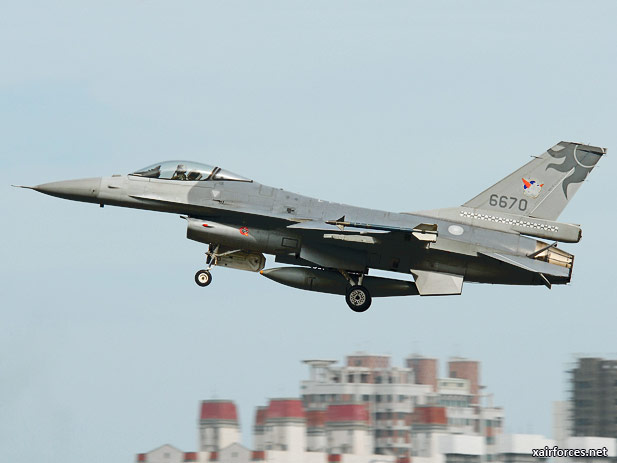
BAE, Lockheed Face Off for Korea, Taiwan F-16 Upgrades

BAE Systems is positioning to challenge Lockheed Martin’s traditional role as the F-16’s sole upgrade provider, and Lockheed is scrambling to meet the challenge in South Korea and Taiwan before BAE builds momentum.
BAE has been slowly moving in on Lockheed’s F-16 upgrade territory. The London-based company is upgrading F-16s for the Turkish Air Force, and the U.S. Air National Guard has approximately 270 F-16s in service that have been upgraded with BAE’s fire control system and advanced Ethernet interface, said Tony Ennis, BAE’s head of Northeast Asia.
“Our comprehensive upgrade solution is based on upgrades we have accomplished on the U.S. Air National Guard which are operational on over 300 U.S Air National Guard F-16s,” Ennis said.
“I think you’ll see more of this as the U.S. market shrinks for new platforms and the U.S. and other countries extend the lifespan of aircraft already in inventory,” said Joel Johnson, international executive director, the Teal Group, Fairfax, Va.
“Bottom line is, I would anticipate primes competing against original primes across the board for upgrades to older platforms. Certainly, a win on one such platform would give a company experience and economies that would help it compete for similar work on similar platforms.”
Lockheed could lose as much as $6 billion if both Seoul and Taipei go with BAE. South Korea is offering a $1.6 billion tender to upgrade 134 KF-16 fighters; Taiwan’s tender is $4 billion to $5 billion for 146 F-16C/D Block 20 fighters. If victorious in South Korea and Taiwan, BAE then would target Singapore for an upgrade to its fleet of more than 70 F-16C/D Block 52 fighters.
Laura Siebert, Lockheed’s F-16 spokeswoman, said BAE had “limited F-16 accomplishments ... and that Lockheed Martin is in the best position to provide upgrades.”
As the original equipment manufacturer (OEM), “we are the only company that can provide our customers an ‘arms around’ solution that includes all the elements of an upgrade avionics, structural, cooling, electrical, weapons certification, etc.,” Siebert said.
Lockheed has delivered more than 1,000 upgrade kits on F-16s around the world and has incorporated active electronically scanned array (AESA) radars into F-16, F-22 and F-35 fighters. After delivery of the modifications, Lockheed will be the only company in a position to continually offer upgrades based upon warfighter experience in the F-16, F-22 and F-35, Siebert said.
BAE is undaunted by Lockheed’s OEM position and its historical role.
Ennis stressed that South Korea’s Air Force would be able to get more sustainable F-16 software and hardware components if it selects BAE as prime integrator because the company is the core supplier of subcomponents, as well as avionic solutions for F-16s.
“As a systems integrator, we have a big advantage over this program as we’re the F-16 subsystems manufacturer and services provider as well,” Ennis said. This allows BAE to better manage its upgrade costs, he said.
BAE’s KF-16 upgrade package will also allow the South Korean Air Force to share source codes more easily for F-16 flight control and weapon control operational flight programs, said Joe McCabe, president of BAE’s South Korea office.
Under a supplier agreement with Hill Air Force Base, Utah, BAE developed the F-16 Commercial Fire Control Computer source code years ago and could provide it to South Korea, he said.
The South Korean Defense Acquisition Program Administration (DAPA) runs the KF-16 upgrade competition in a unique way. In December, BAE and Lockheed each submitted prime integration proposals to DAPA, which will select a final bidder by June. Then it will ask the U.S. government for negotiations with the selected bidder under the Foreign Military Sales (FMS) program.
DAPA adopted this unique style of competition because it wants guaranteed services and performances via FMS while driving down the upgrade costs through full competition.
Col. Kang Byung-ho, head of DAPA’s KF-16 upgrade program team, said his team is examining all aspects of both proposals, including costs and technology-transfer issues, but declined to elaborate.
South Korea is one of the largest importers of U.S. weapons, but skepticism remains high among local arms procurement officials about Washington’s strict restrictions on arms export and technology transfer.
According to industry officials, DAPA is seeking to learn more about avionics and AESA radar technology as South Korea develops an F-16 class KF-X fighter jet along with foreign partners.
In Taiwan, BAE is running into opposition within the Ministry of National Defense (MINDEF), which has had a long relationship with Lockheed Martin and fears the competition could delay the program by 18 to 24 months, said a MINDEF official.
In November, BAE officials indicated Lockheed was allowed to give an F-16 upgrade program briefing to MINDEF, but BAE was barred from doing so despite an October directive issued by Taiwan’s legislature. The directive requires that a letter of acceptance (LOA) for the F-16 package “shall not specify any specific supplier and that the Ministry of National Defense shall request a U.S. team to perform an open competition.”
In the Taiwan competition, BAE plans to drive the price down in a bidding war that placates both the legislature, which has already cut funds for the program by 20 percent, and some within MINDEF, who want an Ethernet option. Lockheed is only now developing and testing an Ethernet option for the F-16 program.
However, time might be against BAE. MINDEF wants an LOA by May and BAE is feeling the pressure.
“We just want a fair competition where everyone has a chance to submit a proposal,” said a BAE official.
Source: 05 March 2011 - DefenceNews
Photo: Republic of China / Taiwanese Air Force F-16C Fighting Falcon (Photo by Taipei Times)
(5.03.2012)
|